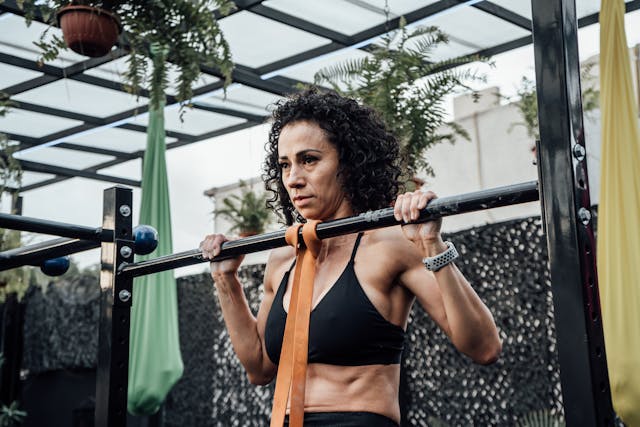
There’s no doubt that a pull-up is one of the most challenging exercises to master. Not only does a pull-up require a strong upper body, but it also requires grip strength and core stability. Even for people who regularly do killer back exercises at the gym, a pull-up is a different type of motion than that of many strength training exercises — making it difficult even for those with a strong back. However, with time, patience, and dedication, anyone can master the pull-up.
There are many approaches to pull-up training, such as using an assisted pull-up machine or performing negative reps. Ultimately, a combination of techniques and exercises can help your body gradually get used to pull-ups and improve over time. Using a pull-up band is a great way for beginners of any skill level to start practicing a pull-up motion. Here’s how.

What is a pull-up band?
If you’re a gym regular, chances are you’ve already seen pull-up bands around the gym. A pull-up band is simply a thick (often made of latex) resistance band that can be used to perform an assisted pull-up. Using a resistance pull-up band can help your back muscles get used to the motion of a pull-up, even when you can’t do one on your own.
By adding the resistance of a band, you’ll reduce the amount of weight your body has to pull up on each rep. These bands come in a variety of difficulty levels which allows beginners to work their way up to more challenging bands over time slowly. As you get stronger, you’ll slowly find yourself able to do more reps at once or move onto a thinner band. Less thick bands provide less weight support, whereas thicker bands provide more assistance during pull-ups.

Choosing the right resistance for your pull-up band
Choosing the right type of pull-up band is important for your pull-band training.
Consider your body weight
One factor to consider is that your body weight will impact the difficulty of pull-ups. The more you weigh, the more weight your body has to lift above the bar. For this reason, those who already begin at a lower body fat may have an easier time progressing through the pull-up stages than those who are overweight. Taking measures to lose some body fat, such as through a healthy diet and regular cardio routine, will also assist you in mastering pull-ups.
Consider your fitness level
Your starting fitness level will also impact the strength of the band you should begin with. Most pull-up bands come in packs with multiple size options, allowing you to try multiple bands until you find the best starting weight for you. Many brands also include a pull-up resistance band chart, which can help you identify which band to begin with based on how many unassisted pull-ups you can do and your starting body weight. Remember, it’s better to begin with a thicker band that provides more assistance to help you master the correct pull-up form. Improper pull-up form can leave you susceptible to injuries and put unnecessary stress on your shoulder blades.

How to use a pull-up band
Once you’ve got the correct pull-up band, you’re ready to begin the training process.
- You’ll need a pull-up bar to attach the resistance band to (either at the gym or at home). If you don’t want to purchase separate gym equipment, check out pull-up bars for home that attach easily to any doorway.
- To properly put the band on the bar, you’ll want to loop one end into the other end of the band and pull tightly to create a knot.
- If you’re on the shorter side, you may need a stool or stand in order to get yourself up onto the bar. Place one foot into the band and grip the bar with an overhand grip. Some people prefer a knee position; however, this may not be an ideal position for anyone with a knee condition.
- Once both hands are placed overhand on the bar, attempt to pull your body above the bar until your chin is above bar level.
- Lower yourself slowly down and repeat for as many repetitions as you can.
If you can perform 10 or more reps easily, it might be a sign that it’s time to move onto a thinner pull-up band.

Mastering unassisted pull-ups
If you want to master an unassisted pull-up, starting with assisted pull-ups using resistance bands is a great place to start. Pull-up bands are an effective and inexpensive place to start, regardless of your current fitness level. Remember, improving at pull-ups and gaining more grip strength takes time and patience. It’s no quick process! In addition, training your back regularly can also help you get stronger and improve your pull-up training too.


